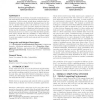MIDDLEWARE
2005
Springer
14 years 5 months ago
2005
Springer
This paper outlines the benefits of adopting serviceoriented architectures at the level of communications between resource-constrained embedded devices, in particular for industri...
MIDDLEWARE
2005
Springer
14 years 5 months ago
2005
Springer
These last years, the evolution of nomadic terminals and mobile networks has yield to the development of the ubiquitous computing. In this context, actual query evaluation and opt...
MIDDLEWARE
2005
Springer
14 years 5 months ago
2005
Springer
Sensor-based services propose to gather, manage, analyze, access and react to sensor data. These services are distributed over heterogeneous platforms. The complexity of the imple...
MIDDLEWARE
2005
Springer
14 years 5 months ago
2005
Springer
Advances in MEMS technology, wireless communications, and digital electronics have enabled the development of low-cost, low-power, multifunctional sensor nodes that integrating th...
MIDDLEWARE
2005
Springer
14 years 5 months ago
2005
Springer
The vision of pervasive or ubiquitous computing, conceived by Mark Weiser, foresees a world where computing is embedded in every day objects. Such objects interact with each other...
MIDDLEWARE
2005
Springer
14 years 5 months ago
2005
Springer
The need for an efficient service management system in an ad-hoc network is obvious. Mobile nodes – and with them the services they provide – frequently enter and leave the ne...
MIDDLEWARE
2005
Springer
14 years 5 months ago
2005
Springer
Currently, the interest in Ambient Intelligence (or AmI) has increased exponentially due to the widespread use of portable devices. Users demand more and more functionality from t...
MIDDLEWARE
2005
Springer
14 years 5 months ago
2005
Springer
This paper presents a content-dependent and configurable framework for the network processing of documents. Like existing compound document frameworks, it enables an enriched docu...
MIDDLEWARE
2005
Springer
14 years 5 months ago
2005
Springer
The content-based publish/subscribe model has been adopted by many services to deliver data between distributed users based on application-specific semantics. Two key issues in su...
MIDDLEWARE
2005
Springer
14 years 5 months ago
2005
Springer
Abstract. Conventional middleware architectures suffer from insufficient module-level reusability and the ability to adapt in face of functionality evolution and diversification....





